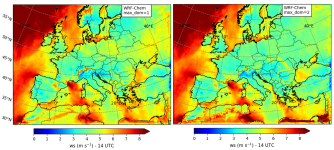vinodkumar
New member
Hello,
I am trying to run WRF with spectral nudging only for the d01 domain in my nested domain set-up according to the namelist as attached in this thread. What I observe is that there are large differences in the output for d01 if I enable nudging (max_dom=2) or not (max_dom=1). In my opinion, d01 output should be identical of max_dom if I do 1-way nesting (feedback=0). As a side note, the nudging is much weaker if I set up max_dom=2. I have attached a plot of monthly mean wind speeds at 14 UTC for ERA5 (nudging data) and the two WRF outputs (max_dom = 1 &2) herewith.
Any leads will be much appreciated.
Best regards,
Vinod
I am trying to run WRF with spectral nudging only for the d01 domain in my nested domain set-up according to the namelist as attached in this thread. What I observe is that there are large differences in the output for d01 if I enable nudging (max_dom=2) or not (max_dom=1). In my opinion, d01 output should be identical of max_dom if I do 1-way nesting (feedback=0). As a side note, the nudging is much weaker if I set up max_dom=2. I have attached a plot of monthly mean wind speeds at 14 UTC for ERA5 (nudging data) and the two WRF outputs (max_dom = 1 &2) herewith.
Any leads will be much appreciated.
Best regards,
Vinod


